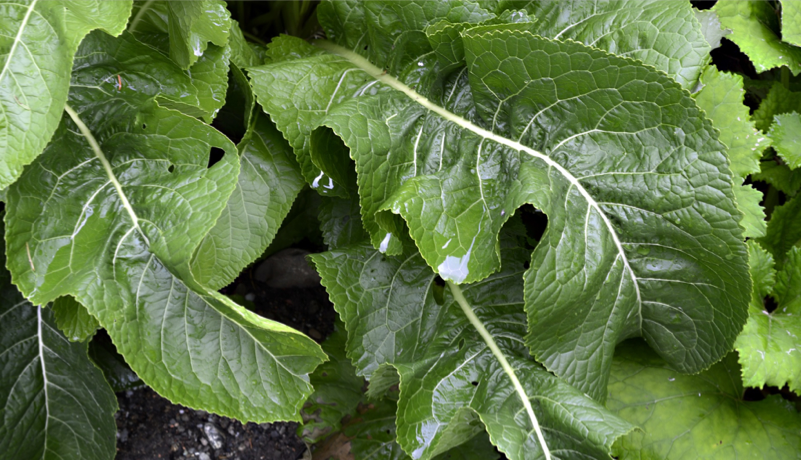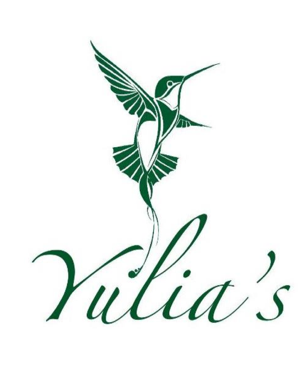Your cart is currently empty!

Old is new again
We all know ordinary horseradish, right? I grew up eating lots of it. My dad likes to spread it on a sourdough bread and eat it with his soup. I always followed his example. It is commonly served with meat dishes, to help digest a fatty meal.
Then I forgot about it. But every time I go back home, there it is again, on the table:-)
This fall it was really talking to me. Some friends from Siberia mentioned that your body will tell you when you have had enough, and it was on.
Growing and harvesting
I have been trying to grow it, and despite the fact that it is easy to propagate and the nature of how it loves to spread, my numerous horseradish plantings never took. This year was a different story, it grew, and looked wonderful. I left the root in the ground to make sure it can multiply and spread next year. It is usually harvested in late fall after the leaves freeze and wilt, all the energy is in the root, or it the early spring, before leaves really come up. For now I use plain store-bought ground up horseradish with vinegar (I buy a simple one with the least amount of ingredients).
Cabbage Potential
Horseradish is in the cabbage family, with mustard being its relative. It has been used as a culinary spice for hundreds of years, and as medicine – much earlier then that.
The root is pretty amazing. It has 5 times more vitamin C then citrus fruit, and is rich in folic acid, retinol (vitamin A), carotene, riboflavin (vitamin B2 – prevents migraines), thiamin (vitamin B1), pantothenic acid (vitamin B5 – prevents muscle cramps and insomnia). Pyridoxine (vitamin B6 – prevention of neurological symptoms and neuropathy). Do you see all those B vitamins? No wonder it gives us lot of energy!
It is minerally rich in calcium, potassium, sodium, sulfur, iron, copper, phosphorus, zinc and manganese. Both root and leaves have phytoncides – natural antibiotics, mustard oils, lysozyme (antimicrobial protein enzyme), sinigrin (natural component of brassica family, like broccoli and Brussels sprouts).
Horseradish also has amino acids (proteins), fiber and starch.
Cold or flu solution
Eat a teaspoon of horseradish twice a day (morning and afternoon) if you have a cold or a flu, or a loss of voice, and use it daily for prevention to support your immune system. Do not dilute, you will have a brain burn, and it is excellent for your sinuses – that is my favorite sensation:-)
You can also mix one part ground horseradish, with one part grated lemon and 1/2 part honey. Keep the mix in the fridge and take spoonful daily. Sometimes I just mix horseradish and honey.
UTI, digestion and reproductive health
It helps with white blood cells production, does not let the cells mutate, and is anti cancer (rectal, colon, lung, etc…) according to a Cornell University study. This spicy plant contains significant amount of glucosinolates – compounds that help liver to detoxify carcinogens. Many studies praise the same components in broccoli (it’s sprouts especially), but horseradish contains 10 times more of them!
Regular use of root activates the stomach and intestines, in case of sluggishness or bloating. It supports gall bladder and therefore eases the elimination. It is great as anemia prevention and supports both male and female potency. Also helpful in cases of vaginitis, odors or itching.It works like a natural antibiotic for UTI and it is officially used in Germany as such, as it increases the kidney secretions, so infections are quickly removed from the body.
The Russian study found that horseradish protects from the environmental toxins, having anti-mutagenic properties.
It lowers cholesterol, balances the blood pressure, nourishes the heart muscles with potassium.
Aches are good
Horseradish regenerates the disk tissues of the vertebras, removes arthritic and gout inflammation of the joints. I can really feel like it is repairing some spots in my body, particularly my foot that got ran over by the yard tractor’s wheel one time some years ago. So if it makes you ache, be glad, it is repairing the tissues:-)
The vegetable is rubefacient, agent that stimulates the blood flow below and to the surface of the skin. So the mentioned earlier sinigrin relives the symptoms of water retention, due to its stimulating effect on the blood capillaries.
Pickle spice
In Russia we use the green leaves of horseradish as a spice for pickles, I think it gives them crunch and a little heat. The leaves can be used in salads too.
Contradictions
If you have stomach ulcer, please be careful and watch the horseradish use, dilute it and discontinue if it makes your symptoms worse. Very light to no use during pregnancy and lactation. It is great in case of hyperthyroid, but go light if you have a hypo condition.
Russian horseradish fun
The Russian word “хрен” (“hren” or horseradish) is actually widely used for number of occasions. How are things? Horseradish! (Meaning not so good:-) Go to horseradish – sends annoying person away. When things aren’t making sense – Horseradish knows.
The Japanese green version of horseradish is wasabi, has had similar uses and history. It is traditionally used with raw sushi or sashimi as an agent of preventing the food poisoning from the unprocessed seafood. It is hard to grow, so the price is steep – $125 per pound.
Do you have one in your garden? Let me know what it does for you:-)


Leave a Reply